Key takeaways:
- Advocacy campaigns effectively combine storytelling and data to evoke emotional responses and drive action for wildlife conservation.
- Successful campaigns involve clear messaging, strong partnerships, and adaptive strategies based on audience engagement metrics.
- Community engagement is crucial, requiring trust-building, collaboration with local influencers, and hands-on activities to create personal connections to conservation issues.
- Learning from past failures, such as cultural misalignment and lack of personal engagement, is vital for shaping future successful advocacy efforts.
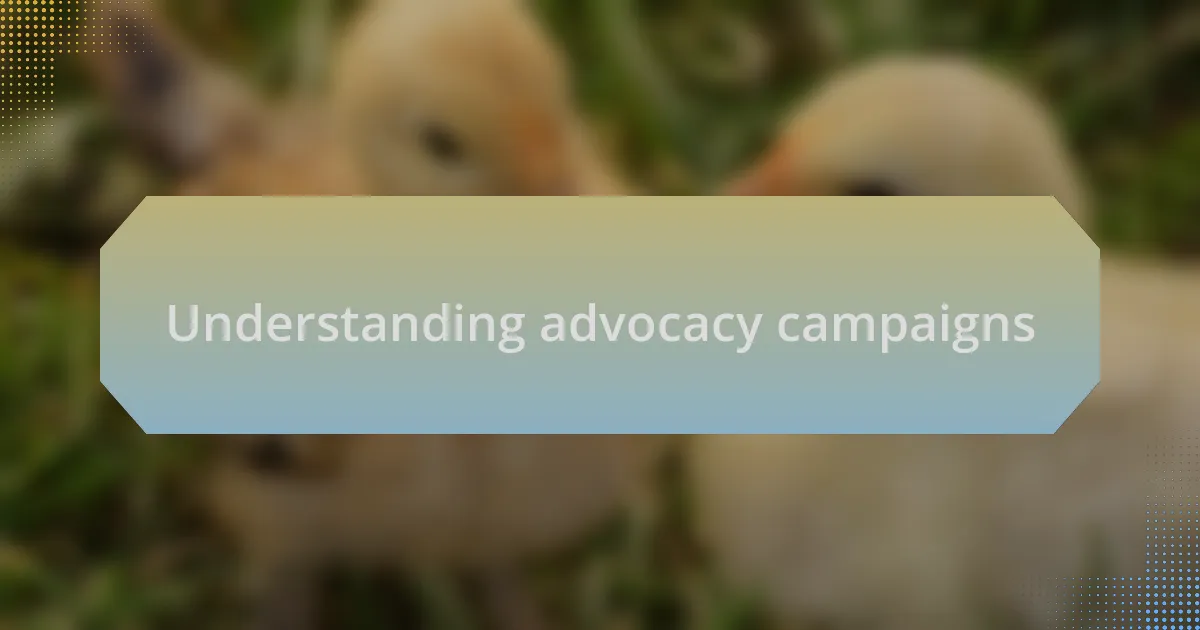
Understanding advocacy campaigns
Advocacy campaigns serve as the bridge between concern and action, igniting a movement for change. I remember attending a community meeting where a local organization detailed their campaign to protect a vital wetland. The passion in the room was palpable; it made me realize how shared convictions can unite people and drive significant action.
These campaigns are built on the power of storytelling, compelling us to feel rather than just think. I’ve often found myself moved by personal stories shared by activists—like that of a farmer whose life was transformed by rewilding practices that brought back native species. What if we all had the courage to share our experiences? That vulnerability can open hearts and motivate others to join a cause.
Additionally, effective advocacy campaigns intertwine knowledge with emotion, creating a lens through which we view important issues. When I first came across statistics about declining wildlife populations, it struck me deeply. Why should numbers matter more than the creatures behind them? By framing data in relatable ways, campaigns help us see the broader implications of our actions, fostering a deeper connection to wildlife conservation.
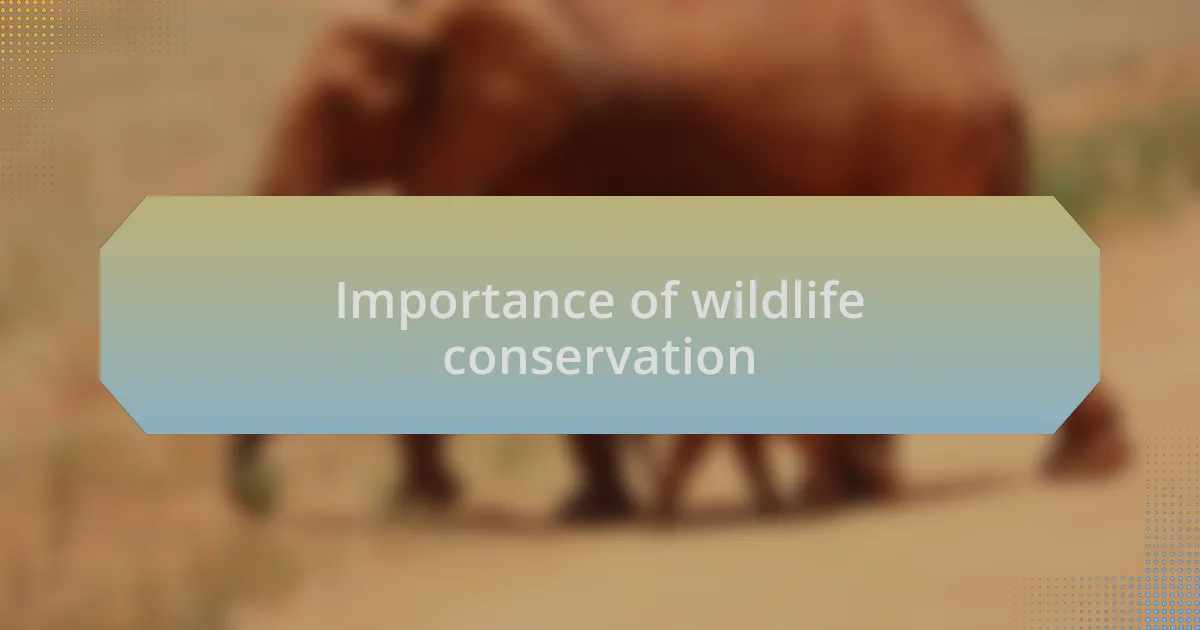
Importance of wildlife conservation
Wildlife conservation is not just about protecting animals; it’s about preserving the intricate balance of ecosystems that sustain life on Earth. I recall a trip to a national park where the harmony of nature was striking—the sound of birds, the rustle of leaves, and the sight of majestic wildlife reminded me that the loss of a single species can ripple through an entire ecosystem. Isn’t it fascinating how each creature plays a role we might not even fully understand?
Moreover, the importance of wildlife conservation extends to human well-being. I’ve seen firsthand how communities thrive when they engage with their natural surroundings, whether through eco-tourism or local conservation efforts. It made me wonder, how often do we overlook the interdependence between our lives and the wildlife that shares this planet with us?
Furthermore, protecting wildlife helps combat climate change and supports biodiversity, which is essential for a resilient future. There was a moment during a community cleanup event where I met a young girl who spoke passionately about her dream of becoming a wildlife biologist. Her enthusiasm struck a chord with me, highlighting how conservation efforts inspire the next generation to cherish and protect our environment. How can we not see that our actions today shape the world they will inherit tomorrow?
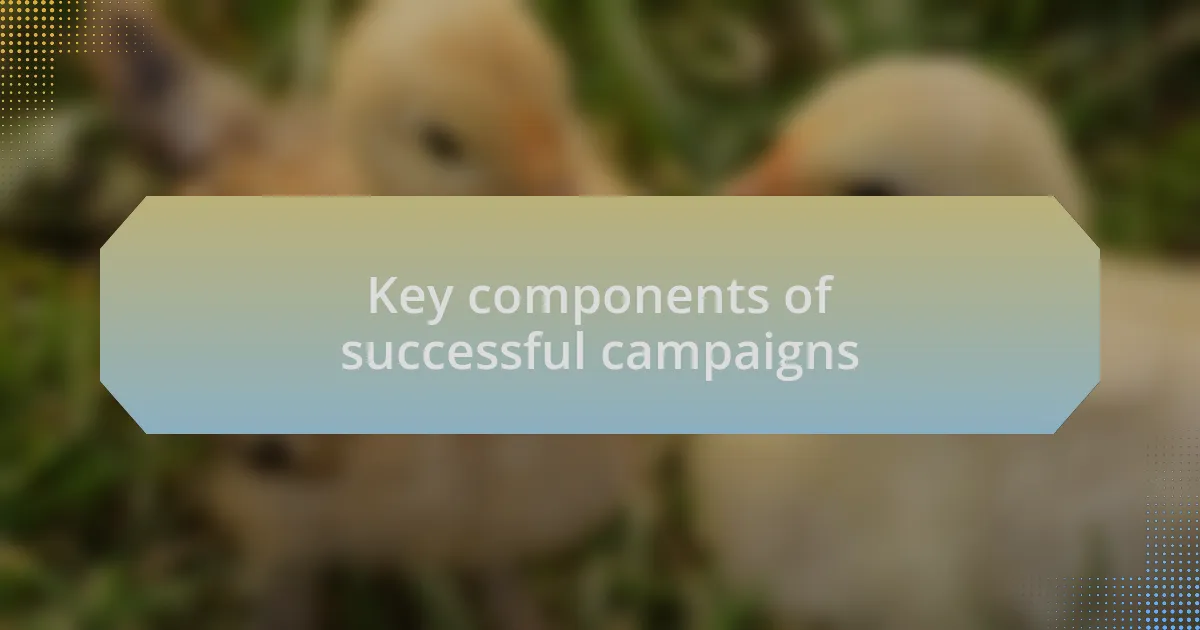
Key components of successful campaigns
Successful advocacy campaigns hinge on a clear and compelling message. In one campaign I worked on, we focused on the plight of a specific endangered species, using captivating imagery and storytelling that resonated with people’s emotions. It was fascinating to see how a well-crafted narrative could transform indifference into empathy and action.
Another key component is building a strong network of partnerships. During a local initiative, I partnered with schools, NGOs, and local businesses. This collaboration not only amplified our outreach but also enriched the campaign with diverse perspectives. Isn’t it amazing how working together can create a larger impact than going it alone?
Lastly, measuring and adapting strategies is essential for success. In my experience, tracking engagement metrics helped us understand what resonated with our audience. When we adjusted our approach based on feedback, our campaign saw increased participation. Have you ever realized how a small tweak can lead to significant changes in impact? It’s a powerful reminder of the importance of staying responsive in advocacy work.
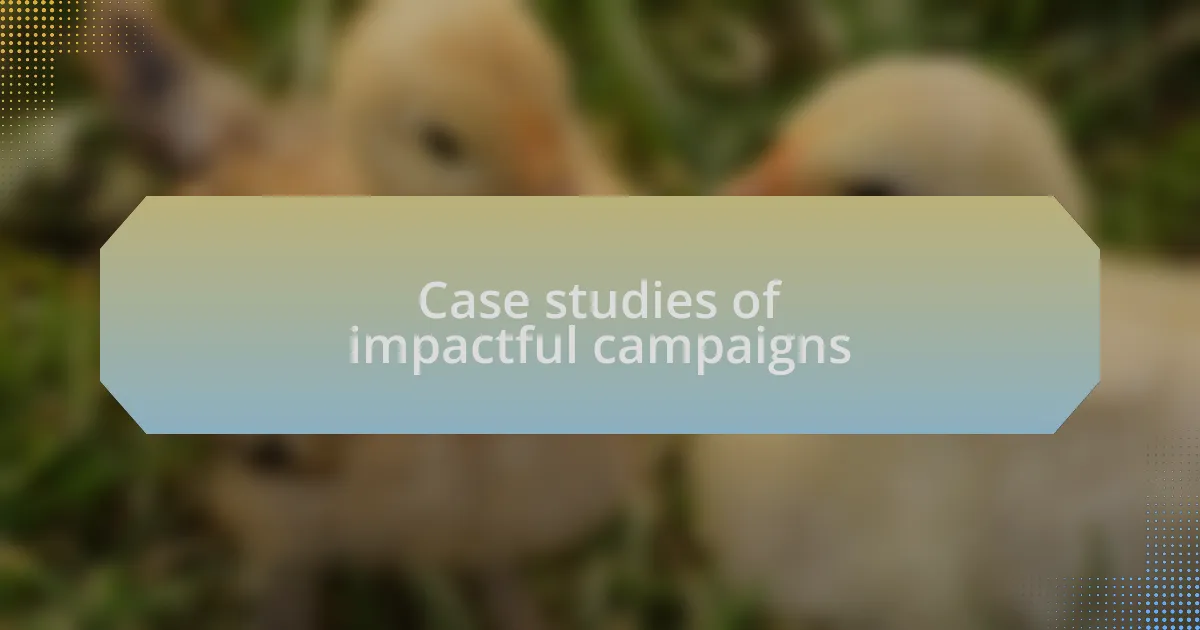
Case studies of impactful campaigns
In my journey through wildlife advocacy, one campaign stood out—an effort to save the vaquita porpoise, the world’s most endangered marine mammal. I remember attending a rally where passionate voices echoed the urgency of the cause. The sheer desperation in those messages really drove home the need for swift action; seeing so many people mobilized left a strong impression on me. But it also raised a vital question: how do we sustain that momentum beyond a single event?
Another remarkable example is the campaign against illegal wildlife trade led by the WWF. I had the chance to witness firsthand the effectiveness of utilizing social media to engage a broader audience. The hashtags and challenges sparked conversations globally, making it not just a national issue but a worldwide conversation. Have you ever been part of something that felt so much bigger than yourself? It was inspiring to see how individual stories could weave into a larger narrative, urging people to take a stand against a global threat.
Lastly, the Save the Rainforest campaign illustrated the importance of visual content in advocacy. I recall crafting a series of infographics that highlighted the biodiversity at stake, which resonated deeply with our audience. The emotional impact was palpable, and the feedback we received emphasized just how powerful a single image can be. Isn’t it fascinating how a visual narrative can stir the conscience and encourage people to act on behalf of our planet’s treasures? This experience crystallized for me the notion that sometimes, a picture truly is worth a thousand words in advocacy.
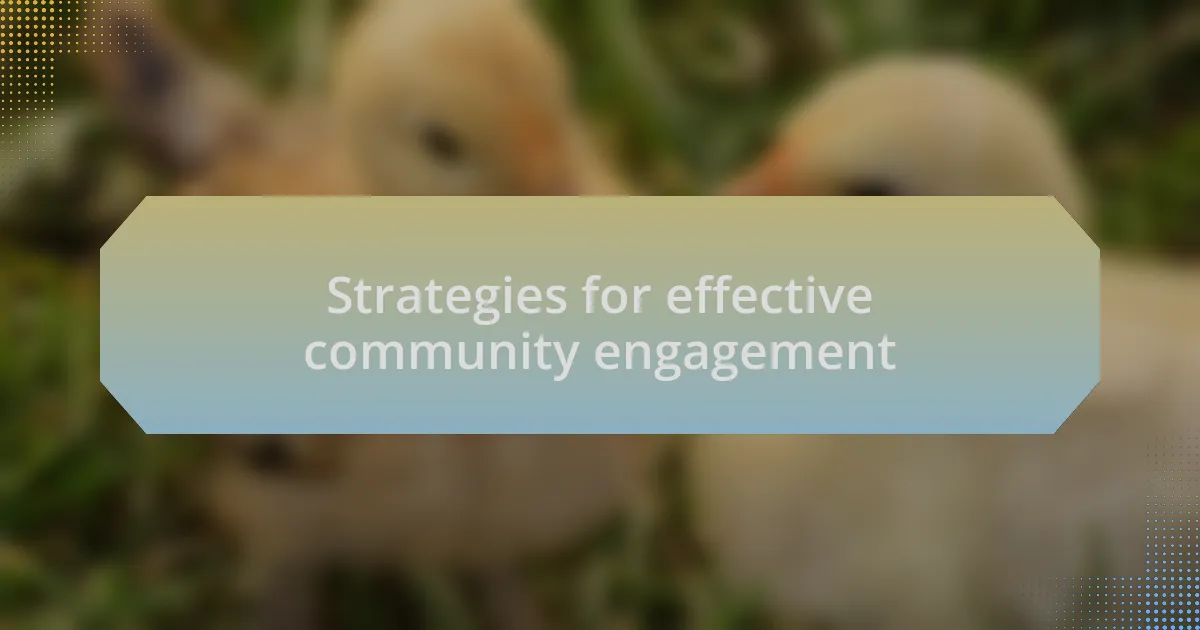
Strategies for effective community engagement
To foster effective community engagement in wildlife advocacy, it’s crucial to cultivate relationships built on trust and shared values. I recall attending a local town hall meeting where community members voiced their concerns about a nearby habitat. This atmosphere of open dialogue not only informed those of us from outside the community but also bridged gaps between local knowledge and broader conservation goals. Isn’t it interesting how listening can often be just as important as presenting information?
Another powerful strategy is partnering with local influencers who genuinely care about wildlife causes. I once collaborated with a well-known local artist who used her platform to amplify conservation messages. Through her artwork and storytelling, she attracted a new audience that might not have engaged otherwise. This experience taught me that when community members see their own voices reflected in advocacy efforts, it ignites a sense of ownership and responsibility. Have you ever noticed how much more compelling a message becomes when it resonates within the community itself?
Utilizing hands-on activities can also draw individuals into the fold. I organized a nature walk that not only showcased local biodiversity but also included interactive discussions on conservation strategies. The excitement in participants’ voices as they identified plant species created a sense of camaraderie, making the issue feel personal. This approach reinforced my belief that involving the community in tangible ways can lead to deeper connections and a lasting impact on advocacy efforts. How do you think experiences like these can transform perceptions of wildlife conservation?
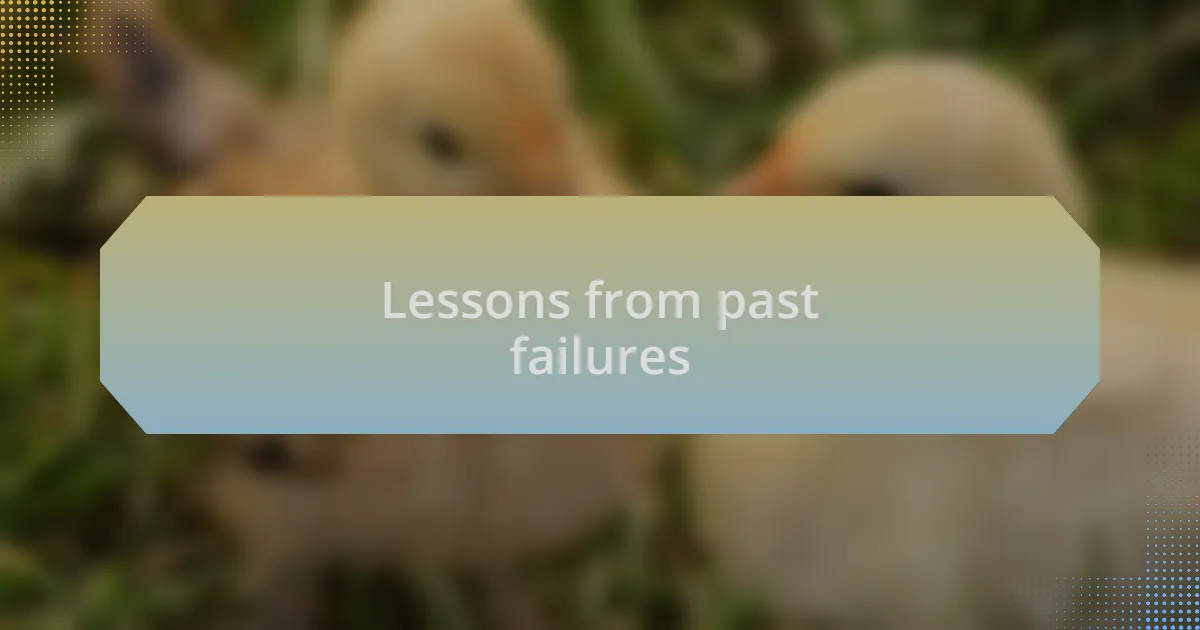
Lessons from past failures
Failures in advocacy campaigns often reveal critical insights that can drive future success. For instance, I once worked on a campaign that overlooked local cultural beliefs when promoting wildlife conservation. We assumed that people would naturally understand the importance of protecting a specific species, but the response was lukewarm. This experience underscored the necessity of integrating cultural perspectives into our message. How often do we forget to ask the community what matters to them?
Another lesson emerged from a campaign that relied too heavily on social media platforms. While we thought this approach would engage younger audiences, the metrics showed otherwise. The lack of face-to-face interaction left many feeling disconnected from the cause. This taught me that personal engagement is irreplaceable. Have you ever felt more motivated after a genuine conversation rather than just a post on a screen?
Moreover, I recall leading a project that aimed to rally support for a wildlife corridor, but we face resistance due to poor timing and inadequate communication. By launching the initiative during a local festival, we missed the chance to highlight its significance when people were most receptive. This taught me the importance of strategic timing and context in engagement efforts. Isn’t it fascinating how a simple oversight like timing can hinder our best intentions?

Ways to implement learned lessons
When applying lessons learned from past advocacy campaigns, it’s vital to actively involve the community in the planning stages. I remember working on a project where locals shared their traditional knowledge about a specific species that was being threatened. This not only fostered a sense of ownership but also enriched our strategy by melding scientific data with cultural insights. Have you considered how local voices could enhance your own campaigns?
Another effective way to implement these lessons is to build strong, personal connections with your audience. During a previous campaign, I organized a series of small, informal gatherings where we discussed wildlife issues over coffee. This face-to-face interaction created an inviting space for open dialogue, making participants feel valued and heard. How can you create those intimate moments in your outreach efforts?
Finally, ensuring that your message aligns with the right timing can significantly improve engagement. I once timed a campaign rollout to coincide with Earth Day, which sparked a responsive wave of interest in our conservation efforts. Reflecting on this, I learned that seizing these moments can amplify awareness and participation. What opportunities do you see on the calendar that you could leverage for your own advocacy work?